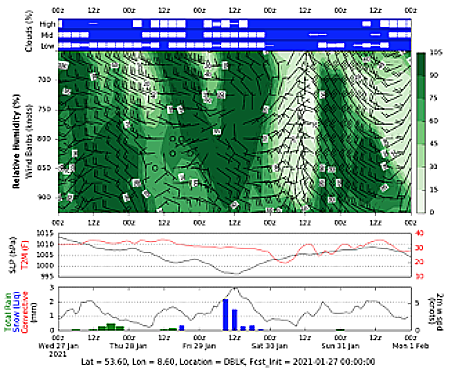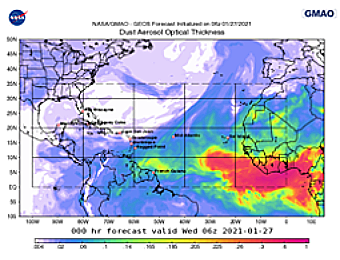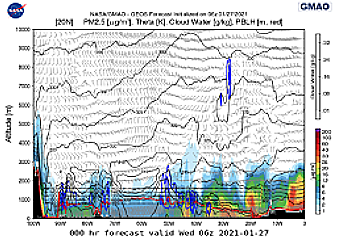The GMAO Supports Field Campaigns During a Challenging Year
02.10.2021
The year 2020 was unpredictable in terms of the planning for airborne and ship-based field campaigns. Most of NASA's planned in situ missions were cancelled or postponed due to the worldwide pandemic, but the GMAO was still able to support a number of missions that required specialized products. The GMAO also supported two staffed campaigns—one that was already underway when the pandemic began, and the other which concluded prior to March 2020.
Leaving Tromsø, Norway on September 20, 2019, the German research icebreaker Polarstern began a 389-day expedition, called Multidisciplinary drifting Observatory for the Study of Arctic Climate (MOSAiC), drifting through the Arctic Ocean while trapped in sea ice. The goal of the MOSAiC expedition was to observe the Arctic atmosphere, ocean, sea ice, biogeochemistry and ecosystem during the historic expedition. The GMAO provided a custom North Pole-centered visualization page on the Framework for Live User-Invoked Data (FLUID) web site for use in tracking the weather and chemistry over the entire year-long campaign. The monitoring team also developed an aerosol and carbon datagram suite, which automatically updated the daily location of the Polarstern's journey through the Arctic Ocean.

In January 2020, the Atmospheric Reactive Nitrogen cycling over the oceAn (ARNA) campaign, funded by the United Kingdom’s National Environmental Research Council, flew for two weeks in and around Cape Verde to observe the interactions between dust and NOx through the marine atmosphere. Direct downloads of GEOS-CF and GEOS-FP data through OpenDAP were used to prepare visualizations for their flight team.
In summer 2020, the recurring Arctic-Boreal Vulnerability Experiment (ABoVE) campaign was suspended until 2021, but GMAO still had the opportunity to provide support for two “virtual” flight campaigns over the tropical Atlantic/Caribbean region. One was the Calima-Public Health (Calima-PH) and the other was the Convective Processes Experiment—Aerosol and Winds (CPEX-AW), which the support team referred to as PRDUST (Puerto Rico dust). Amidst challenges, the campaign support team delivered various complex products on time, including an interactive map that allows users to bring up datagrams for a station with one click; and a full page of latitude-longitude cross-section plots displaying various chemical and aerosol fields, including PM2.5 and PM total, which had to be newly calculated for these missions.


Support was resumed for the University of Miami’s Cloud-Aerosol-Rain Observatory (CAROb) project for a second year. The field campaign support team provided animations of dust and aerosol transport over the Atlantic Ocean to compare to the University’s LiDAR observations from June through mid-November 2020.
The PI of the CAROB project, Paquita Zuidema, stated “the support over the summer was wonderful because it was such a dusty summer.” She found it helpful in studying the year’s long dust season and requested two extensions to the support timeframe.


